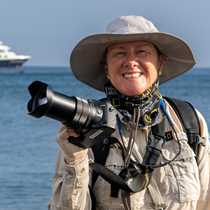Santa Cruz Island
It is somewhat of a shock to wake up on approach to Academy Bay and see the undeniable evidence of human presence in the islands. Yesterday we were on the most pristine of islands, as far from a civilizing influence as we could possible get, and now?
But there is a reason to this seeming madness. Pirates first, followed by whalers and sealers, then finally settlers of many kinds; convicts exiled from the mainland, people escaping their old lives, people looking for new lives. Santa Cruz is a beautiful island that rises to 2,850-plus feet and demonstrates all of the vegetation zones found on the southeast sides of the larger islands. The southeast trade winds bring constant moisture that over eons has built up a soil layer. It is modest by anyone else's account, but here is enough to grow certain crops on a small scale, and raise beef and dairy cattle. So people stayed.
The inhabitants have access to an airport by crossing over to the opposite side, then taking a small ride in a foot ferry to Baltra Island. Being the first and only airport in Galápagos for decades, the town on Santa Cruz Island became the logical location for important organizations. The National Park headquarters were established here in the early 1960's, as well as the Charles Darwin Research Station.
Today it is a bustling town known as Puerto Ayora with cars and buses and folk on bicycles and foot. We spent time in town as well as at the park-run Tortoise Rearing Center where we said hello to Diego the Superstud, Lonesome George of International Renown and many more of their ilk.
In the highlands tortoises were rambling the fields grazing, or sitting in ponds dozing. A vermillion flycatcher made an appearance, a rare sighting!
Everyone came home filled with sensory overload, ideas and full memory cards (digital and mental).



